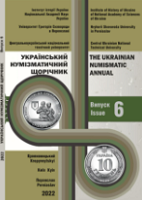ЩОДО ЕПОНІМНОГО ДАТУВАННЯ МОНЕТ ОЛЬВІЇ V–I СТ. ДО Р. Х.
ABOUT EPONYMOUS DATING OF OLBIAN COINS V-I CENTURY BC.
Author(s): Mykola NikolaevSubject(s): Archaeology, Cultural history, Economic history, Ancient World, Methodology and research technology
Published by: ДВНЗ Переяслав-Хмельницький державний педагогічний університет імені Григорія Сковороди
Keywords: Olbia; coins; dating; eponyms; monograms; chronology; interpretation;
Summary/Abstract: During 2008–2016, on the basis of system research, in that case, mathematical modelling, we carried out explorations to restore the chronology of Pontic Olbia for the period of the IV–I centuries BC. Considering that the chronology of Olbia IV - the beginning of the I century BC has an eponymous character, at the same time, the foundations of the prosopography of the Olbian elite families were developed. This made it possible to carry out relatively accurate prosopographic dating and prosopographic interpretation by real historical persons of many various epigraphic monuments, in particular, lapidary inscriptions, magical incantations, and ceramic seals. Gaining the experience of such research made it possible to proceed to the interpretation and absolute dating of the most difficult monuments in this sense - coin legends (letters, abbreviations, monograms). Analysis of recent research and publications. As a result of the research of the Olbian coins legends of the IV centuries BC, and "Borysthenes" (330-218 years BC) we received the next result: letters, abbreviations, and monograms on the copper coins of Olbia IV-III centuries BC has the magistrates character. The research carried out so far has not made it possible to directly identify the eponymous date in the legends of the classical and Hellenistic periods. Meanwhile, the famous Ukrainian numismatist V. O. Anokhin proposed many hypotheses about the eponymous character of individual letters and monograms in the series ΟΙ ΕΠΤΑ, ΠΕΕ, ΣΩΜΟΙ, ΒΣΕ etc. The purpose of the paper is the first attempt to (selectively) identify individual letters, abbreviations, and monograms on the coins of classical and Hellenistic Olbia as designations of the eponymous date, in particulate, the series ΟΙ ΕΠΤΑ, ΠΕΕ, ΣΩΜΟΙ, ΒΣΕ. Research methodology – typical scientific methods in combination with the author’s own scientific work by synchronization of the eponymous catalogue IPE I2 201 (calendar) and Olbia’s prosopography. Also, we used the previously proposed tool of chronological modelling in coinage: ancestral inheritance of coin abbreviations and monograms. Scientific novelty. On a system basis, with the use of new chronological tools researched, the legends, letters, and monograms of coins of classical and Hellenistic Olbia. In particular, series ΟΙ ΕΠΤΑ, ΠΕΕ, ΣΩΜΟΙ, ΒΣΕ, which, according to V. O. Anokhin, indicate the eponymous date, were studied for the first time. Conclusions about the use of eponymous dating in Olbia's coin business have been formed. A number of side results were obtained, in particular, the period of "Borysthenes" being in circulation after the termination of their emission, and the specifics of the issuance of the decree IPE I2 76 on the tariffs for sacrificial offerings were clarified. The beginning of the emission of the ΒΣΕ series has been clarified, and an alternative in the interpretation of this abbreviation has been offer etc. Conclusions. 1. During the classical-hellenistic period (V-I centuries BC) in the coinage of Olbia, according to the current level of knowledge, only two cases of coin dating by the eponymous date have been recorded. The first is a mention of the year of aisymnetus of the molpoi Pavs(anius?) in the first half of the 5th century BC – ΕΠΙ ΠΑΥΣΑ. The second is the dating of the year of Apollo (105 BC) of a coin with a letter on the obverse (sic) of the time of Mithridates VI Eupator, recently made public by Prof. V. M. Orlyk. 2. In the III-II centuries BC, there probably was a formal change in the organization of the coin business in relation to the IV century BC: outwardly, this manifested itself in the fact that instead of symbols such as a star, crescent, legends ΟΙ ΕΠΤΑ, ΠΕΕ, ΣΩΜΟΙ, ΒΣΕ etc., were used. 3. Individual letters and monograms, which by V.O. Anokhin considered to be eponymous dates and which are present on the series ΟΙ ΕΠΤΑ, ΠΕΕ, ΣΩΜΟΙ, ΒΣΕ, are marks of magistrates. 4. Coins with the legend ΟΙ ΕΠΤΑ, contrary to P. O. Karyshkovsky's hypothesis, are not related to overcoming the financial crisis. 5. After the cessation of coinage in 218-216 BC, "Borysthenes" were in circulation until the turn of the III-II centuries BC, after which they were replaced by the ΒΣΕ series. The ΒΣΕ series, in particular, with additional letters was minted during 200-191 BC. 6. Decree IPE I2 76 on sacrificial tariffs mentions precisely "Borysthenes" as a copper coin. 7. The traditional interpretation of the abbreviation ΒΣΕ by researchers as holding the position of the king (by O. M. Zograf and P. O. Karyshkovsky), in that case, Saitafarn (by V. O. Anokhin), is erroneous. 8. Complex coin legend of the Protogeneous family ΕΥΠΡ, , ΠΡΩΤΗΡ mention one person. Other complex legends, for example ΕΙΕΥ, ΣΩΜΟΙ, mention two persons. 9. Formed hypotheses, taking into account the complexity of real processes in the coin business of Olbia, should be considered preliminary. 10. A promising direction for further research should be the combination of the chronological tools we use with purely numismatic studies.
Journal: Український Нумізматичний Щорічник
- Issue Year: 2022
- Issue No: 6
- Page Range: 71-93
- Page Count: 23
- Language: Ukrainian

